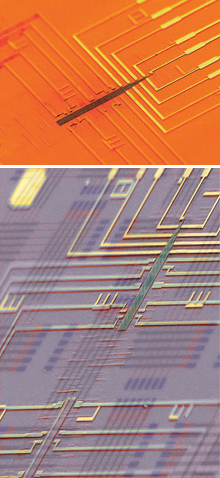Science Fiction
Dictionary
A B C D E F G H I J K L M N O P Q R S T U V W X Y Z
Nanowire Transistors For Smallest Computers

Nanowire transistors could form the basis for the tiniest computers possible, says a team led by Charles Lieber, a professor of chemistry at Harvard, and Shamik Das, lead engineer in MITRE's nanosystems group.
They built a reprogrammable circuit out of nanowire transistors; taken together, you wind up with the first scalable nanowire computer.
The nanowire transistors maintain their state-on or off—regardless of whether the power is on. This gives it an instant-on capability, important for low-power sensors that might need to collect data only sporadically and also need to conserve power.
To make the new nanowire circuit, researchers deposited lines of nanowires, made of a germanium core and silicon shell, on a substrate and crossed them with lines of metal electrodes to create a grid. The points where the nanowires and electrodes intersect act as a transistor that can be turned on and off independently. The researchers made a single tile, with an area of 960 square microns containing 496 functional transistors. It is designed to wire to other tiles so that the transistors, in aggregate, could act as complex logic gates for processing or memory.

(Smallest computers yet?)
Top: Scanning electron microscopy (SEM) image of a programmable
nanowire logic circuit tile assembled bottom-up for computational
functionalities such as full-adder. The tile can be scaled up into a
fully-functional integrated nanoprocessor
Bottom: This false-colored scanning electron microscope image
shows a nanowire processor tile superimposed on top of the
architecture used to design the circuit.
These circuits could be as much as ten times more power-efficient than circuits made of traditional materials. Nanowire doesn't allow electric current to leak, and the design uses capacitive connections instead of resistive ones.
This is the kind of computing size and power you'd need to implement the nanomachine swarm from Stanislaw Lem's amazing 1954 novel The Invincible:
"Two types of systems were successful in this evolutionary pattern: first, those that made the greatest progress in miniaturization and then those that became settled in a definite place. The first type were the beginning of these 'black clouds.' I believe them to be very tiny pseudo insects that, if necessary, and for their common good, can unite to form a superordinate system. This is the course taken by the evolution of the mobile mechanisms."
(Read more about Lem's nanomachine swarms)
Fans of Philip K. Dick are also anticipating the arrival of the autofac from his 1955 short story of the same name:
The pellet was a smashed container of machinery, tiny metallic elements too minute to be analyzed without a microscope...The bits were in motion. Microscopic machinery, smaller than ants, smaller than pins, working energetically, purposefully - constructing something that looked like a tiny rectangle of steel.
From Lieber research group via Technology Review.
Scroll down for more stories in the same category. (Story submitted 2/10/2011)
Follow this kind of news @Technovelgy.| Email | RSS | Blog It | Stumble | del.icio.us | Digg | Reddit |
Would
you like to contribute a story tip?
It's easy:
Get the URL of the story, and the related sf author, and add
it here.
Comment/Join discussion ( 0 )
Related News Stories - (" Computer ")
Is Agentic AI The Wrong Kind Of Smartness?
'It’s smart enough to go wrong in very complicated ways, but not smart enough to help us find out what’s wrong.' - Isaac Asimov, 1975.
Jetson Orin Nano Super 70 Just $249
'Rayno folded up the microterm and tucked it back inside his jumper.' - Bruce Bethke, 1983.
Automatic Bot Traffic Is 38 Percent Of HTTP Requests
'there were so many worms and counterworms loose in the data-net...' - John Brunner, 1975
Neuroplatform Human Brain Organoid Bioprocessor Uses Less Electricity
'Cultured brains on a slab.'- Peter Watts, 1999
Technovelgy (that's tech-novel-gee!) is devoted to the creative science inventions and ideas of sf authors. Look for the Invention Category that interests you, the Glossary, the Invention Timeline, or see what's New.
Science Fiction
Timeline
1600-1899
1900-1939
1940's 1950's
1960's 1970's
1980's 1990's
2000's 2010's
Current News
Natural Gait With Prosthetic Connected To Nervous System
'The leg was to function, in a way, as a servo-mechanism operated by Larry’s brain...'
Woman Marries Computer, Vonnegut's Dream Comes True
'Men are made of protoplasm... Lasts forever.'
Spidery 'Walk Me' Toyota Autonomous Wheel Chair Like Star Wars
Walk along with the emperor.
Dancing Robots Taught Dance Moves
'A clockwork figure would be the thing for you...'
Proof Of Robothood - Not A Person
'Who are you people? - Show 'em.'
Indonesian Clans Battle
'The observation vehicle was of that peculiar variety used in conveying a large number of people across rough terrain.'
The 'Last Mile' In China Crowded With Delivery Robots
Yes, it's a delivery robot. On wheels.
Tornyol Microdrone Kills Mosquitoes
'The real border was defended by... a swarm of quasi-independent aerostats.'
PLATO Spacecraft, Hunter Of Habitable Planets, Now Ready
'I ... set my automatic astronomical instruments to searching for a habitable planet.'
Factory Humanoid Robots Built By Humanoid Robots
'...haven't you a section of the factory where only robot labor is employed?'
iPhone Air Fulfils Jobs' Promise From 2007 - A Giant Screen!
'... oblongs were all over the floor and surfaces.'
ChatGPT Now Participates in Group Chats
'...the city was their laboratory in human psychology.'
iPhone Pocket All Sold Out!
'A long, strong, slender net...'
Did The Yautja Have These First?
What a marvel of ingenuity the little device was!
Jetson ONE Air Races Begin, Can Air Polo Be Far Behind?
'If you're one of those rarities who haven't attended a rocket-polo "carnage", let me tell you it's a colorful affair.'
Will Space Stations Have Large Interior Spaces Again?
'They filed clumsily into the battleroom, like children in a swimming pool for the first time, clinging to the handholds along the side.'
